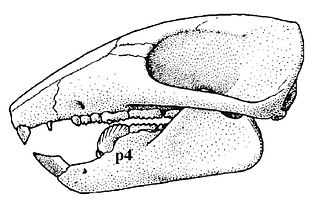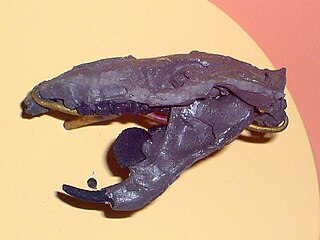
Lambdopsalis bulla is an extinct multituberculate mammal from the Late Paleocene of China and Mongolia. It is placed within the suborder Cimolodonta and is a member of the superfamily Taeniolabidoidea. Fossil remains have been found in the Late Paleocene Nomogen and Khashat Formations in Nao-mugen and Bayn Ulan of China and Mongolia.

Cimexomys is an extinct North American mammal that lived from the Upper Cretaceous to the Paleocene. For a while, it shared the world with dinosaurs, but outlived them. It was a member of the extinct order Multituberculata and lies within the suborder Cimolodonta. It is perhaps a member of the Paracimexomys group, though it is not certain.

Nemegtbaatar is a genus of mammal from the Upper Cretaceous Period of what is now Mongolia. It existed in the company of much larger dinosaurs, found together in the Nemegt Basin. This creature was a member of the extinct order Multituberculata. It is within the suborder Cimolodonta and is a member of the superfamily Djadochtatherioidea. It was a hopping, gerboa-like species.

Taeniolabidoidea is a group of extinct mammals known from North America and Asia. They were the largest members of the extinct order Multituberculata, as well as the largest non-therian mammals. Lambdopsalis even provides direct fossil evidence of mammalian fur in a fairly good state of preservation for a 60-million-year-old animal. Some of these animals were large for their time; Taeniolabis taoensis is the largest known multituberculate and though smaller, Yubaatar is the largest known Mesozoic Asian multituberculate. Average members of the Taeniolaboidea were about beaver-sized and the largest even reached sizes comparable to the largest beavers like Castoroides, up to about 100 kilograms.
Sphenopsalis is a genus of extinct mammal from the Paleocene of Central Asia. It was a member of the extinct order Multituberculata, and lies within the suborder Cimolodonta and the superfamily Taeniolabidoidea. The genus was named by William Diller Matthew, W. Granger and George Gaylord Simpson in 1928.
Eucosmodontidae is a poorly preserved family of fossil mammals within the extinct order Multituberculata. Representatives are known from strata dating from the Upper Cretaceous through the Lower Eocene of North America, as well as the Paleocene to Eocene of Europe. The family is part of the suborder of Cimolodonta. They might be related with the Djadochtatherioidea but without further finds, this remains unclear. Other than a partial snout, fossil evidence is limited to teeth.
Eucosmodon is a genus of extinct mammal from the Paleocene of North America. It is a member of the extinct order of Multituberculata within the suborder of Cimolodonta, and the family Eucosmodontidae. This genus has partly also been known as Neoplagiaulax. All known fossils of this small mammal are restricted to teeth.
Clemensodon is a genus of extinct mammal from the Upper Cretaceous of North America. It lived during the end of the Mesozoic, also known as the "age of the dinosaurs". It was a member of the extinct order of Multituberculata within the suborder of Cimolodonta and family Eucosmodontidae. Fossil remains are restricted to teeth.
Stygimys is an extinct mammal genus from the Upper Cretaceous and Paleocene of North America. It was a member of the extinct order Multituberculata within the suborder Cimolodonta, family Eucosmodontidae.
Microcosmodontidae is a poorly preserved family of fossil mammals within the extinct order Multituberculata. Representatives are known from the Lower Paleocene of North America. The family is part of the suborder Cimolodonta. Other than that, their systematic relationships are hard to define.
Acheronodon is a genus of herbivorous arboreal mammal which belongs to the family Microcosmodontidae and which was endemic to North America during the Early Paleocene subepoch and in existence for approximately 9.2 million years.

Kogaionon is a mammal genus from the Upper Cretaceous of Romania. It lived in Transylvania the same time as some of the last non-avian dinosaurs and was a member of the extinct order of Multituberculata. It was named after Kogaionon, the holy mountain of the ancient Dacians. It lies within the suborder Cimolodonta and the family Kogaionidae. The genus Kogaionon was named by Rădulescu R. and Samson P. in 1996.

Barbatodon is a mammal genus from the Upper Cretaceous period. It lived in Transylvania at the same time as some of the last dinosaurs and was a member of the extinct order of Multituberculata. It is within the suborder of Cimolodonta, and the family Kogaionidae. The genus Barbatodon was named by Rãdulescu R. and Samson P. in 1986.
Hainina is an extinct mammal genus from the latest Cretaceous to the Paleocene of Europe.
Cimolomyidae is a family of fossil mammal within the extinct order Multituberculata. Representatives are known from the Upper Cretaceous and the Paleocene of North America and perhaps Mongolia. The family is part of the suborder Cimolodonta. Other than that, their systematic relationships are hard to define. Some authors have placed the taxon within Taeniolabidoidea. Kielan-Jaworowska and Hurum (2001) expressly don't.

Cimolomys is a mammal genus from the Upper Cretaceous of North America. It was a member of the extinct order Multituberculata within the suborder Cimolodonta and family Cimolomyidae.
Buginbaatar is an extinct genus of mammal from the Upper Cretaceous of Mongolia. It is a member of the extinct order Multituberculata, within the suborder Cimolodonta and family Cimolomyidae. It lived towards the end of the Mesozoic era.
Essonodon is a mammal genus from the Upper Cretaceous of North America. It was a member of the extinct order Multituberculata and lived towards the end of the "age of the dinosaurs." It is within the suborder Cimolodonta and perhaps the family Cimolomyidae.
Viridomys is a genus of extinct mammal from the Upper Cretaceous of North America. It was a member of the extinct order of Multituberculata, and lived during the Mesozoic, also known as the "age of the dinosaurs." It's within the suborder of Cimolodonta, though its further affinities are unclear.

Hațeg Island was a large offshore island in the Tethys Sea which existed during the Late Cretaceous period, probably from the Cenomanian to the Maastrichtian ages. It was situated in an area corresponding to the region around modern-day Hațeg, Hunedoara County, Romania. Maastrichtian fossils of small-sized dinosaurs have been found in the island's rocks. It was formed mainly by tectonic uplift during the early Alpine orogeny, caused by the collision of the African and Eurasian plates towards the end of the Cretaceous. There is no real present-day analog, but overall, the island of Hainan is perhaps closest as regards climate, geology and topography, though still not a particularly good match. The vegetation, for example, was of course entirely distinct from today, as was the fauna.










